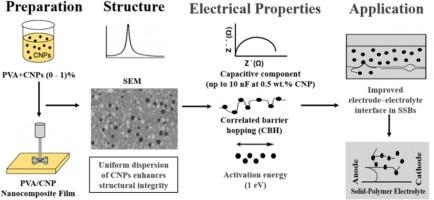低浓度碳纳米颗粒对增强聚乙烯醇纳米复合材料的介电和导电性能的协同效应
IF 4.6
3区 材料科学
Q2 MATERIALS SCIENCE, MULTIDISCIPLINARY
引用次数: 0
摘要
全球向可再生能源的转变需要先进、安全和可扩展的能源存储解决方案。固态电池(SSBs)显示出巨大的前景,但也面临着诸如电解质-电极界面差以及离子电导率低等重大挑战。本研究探讨了在聚乙烯醇(PVA)基纳米复合材料中加入碳纳米粒子(CNPs)的协同效应,以改善电解质和电极之间的相互作用,同时保持复合材料的绝缘性能。采用机械混合法制备了CNP浓度为0 ~ 1wt %的PVA/CNP薄膜。结构、形态和电学性能的综合表征表明,CNP的加入增强了结晶度(XRD),导致了相对均匀的分布(SEM)。电学测试表明,当CNP浓度为1wt %时,材料的电阻增加,导电性降低。这种效应与陷阱位置的产生和带电粒子之间的相互作用有关,其能量需求约为1ev。Nyquist图确定了一个电容成分(在0.5 wt% CNP下高达10 nF),而相关垒跳(CBH)被确定为主要的传导机制,与观察到的形态特征一致。这些发现有望推动PVA/CNP纳米复合材料的设计,以改善固态电解质。本文章由计算机程序翻译,如有差异,请以英文原文为准。

Synergistic effect of low-concentration carbon nanoparticles on enhancing dielectric and conductive properties of polyvinyl alcohol nanocomposites for high-performance electrolytes in solid-state batteries
The global shift to renewable energy demands advanced, safe, and scalable energy storage solutions. Solid-state batteries (SSBs) show great promise but face significant challenges such as poor electrolyte–electrode interfaces in addition to low ionic conductivity. This study investigates the synergistic effects of incorporating carbon nanoparticles (CNPs) into polyvinyl alcohol (PVA)-based nanocomposites to improve the interaction between the electrolyte and electrode while maintaining the insulating properties of the composite material. The PVA/CNP films with CNP concentrations ranging from 0 to 1 wt% were synthesized via mechanical mixing. Comprehensive characterization of the structural, morphological, and electrical properties revealed that CNP incorporation enhanced the crystallinity (XRD), resulting in a relatively uniform distribution (SEM). Electrical tests showed that at 1 wt% CNP, the material exhibited increased resistance and reduced electrical conductivity. This effect has been linked to the creation of trap sites and interactions between charged particles with an energy requirement of approximately 1 eV. The Nyquist plots identified a capacitive component (up to 10 nF at 0.5 wt% CNP), while correlated barrier hopping (CBH) was determined to be the dominant conduction mechanism, consistent with the observed morphological characteristics. These insights are expected to advance the design of PVA/CNP nanocomposites for improved solid-state electrolytes.
求助全文
通过发布文献求助,成功后即可免费获取论文全文。
去求助
来源期刊

Materials Science and Engineering: B
工程技术-材料科学:综合
CiteScore
5.60
自引率
2.80%
发文量
481
审稿时长
3.5 months
期刊介绍:
The journal provides an international medium for the publication of theoretical and experimental studies and reviews related to the electronic, electrochemical, ionic, magnetic, optical, and biosensing properties of solid state materials in bulk, thin film and particulate forms. Papers dealing with synthesis, processing, characterization, structure, physical properties and computational aspects of nano-crystalline, crystalline, amorphous and glassy forms of ceramics, semiconductors, layered insertion compounds, low-dimensional compounds and systems, fast-ion conductors, polymers and dielectrics are viewed as suitable for publication. Articles focused on nano-structured aspects of these advanced solid-state materials will also be considered suitable.
 求助内容:
求助内容: 应助结果提醒方式:
应助结果提醒方式:


